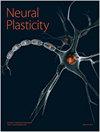脑卒中后失语症后小脑区域改变和脑小脑系统重组
IF 3.7
4区 医学
Q2 Medicine
引用次数: 5
摘要
近年来,越来越多的研究强调了小脑在语言处理中的作用。然而,脑卒中后失语症在小脑和脑小脑系统中所起的神经重组作用尚不清楚。为了解决这一问题,在本研究中,我们采用结构和静息状态功能磁共振成像(fMRI)技术相结合的方法研究了小脑的区域变化以及脑小脑回路的功能重组。本研究招募了20名左半球卒中后失语患者和20名年龄匹配的健康对照(hc)。使用西方失语电池(WAB)测试来评估参与者的语言能力。对每个参与者的灰质体积、自发脑活动、功能连通性和有效连通性进行了检查。我们发现,患者组右小脑第六小叶和右小腿的灰质体积显著降低,这些区域的脑活动与WAB评分显著相关。我们还发现交叉脑小脑回路的功能连通性下降,这与WAB评分显著相关。此外,发现小脑和对侧大脑之间的信息流发生了改变。总之,我们的研究结果为脑卒中后失语症后小脑内的区域改变和脑小脑系统的重组提供了证据,并强调了脑卒中后失语症患者小脑在语言处理中的重要作用。本文章由计算机程序翻译,如有差异,请以英文原文为准。
Regional Alteration within the Cerebellum and the Reorganization of the Cerebrocerebellar System following Poststroke Aphasia
Recently, an increasing number of studies have highlighted the role of the cerebellum in language processing. However, the role of neural reorganization within the cerebellum as well as within the cerebrocerebellar system caused by poststroke aphasia remains unknown. To solve this problem, in the present study, we investigated regional alterations of the cerebellum as well as the functional reorganization of the cerebrocerebellar circuit by combining structural and resting-state functional magnetic resonance imaging (fMRI) techniques. Twenty patients diagnosed with aphasia following left-hemispheric stroke and 20 age-matched healthy controls (HCs) were recruited in this study. The Western Aphasia Battery (WAB) test was used to assess the participants' language ability. Gray matter volume, spontaneous brain activity, functional connectivity, and effective connectivity were examined in each participant. We discovered that gray matter volumes in right cerebellar lobule VI and right Crus I were significantly lower in the patient group, and the brain activity within these regions was significantly correlated with WAB scores. We also discovered decreased functional connectivity within the crossed cerebrocerebellar circuit, which was significantly correlated with WAB scores. Moreover, altered information flow between the cerebellum and the contralateral cerebrum was found. Together, our findings provide evidence for regional alterations within the cerebellum and the reorganization of the cerebrocerebellar system following poststroke aphasia and highlight the important role of the cerebellum in language processing within aphasic individuals after stroke.
求助全文
通过发布文献求助,成功后即可免费获取论文全文。
去求助
来源期刊

Neural Plasticity
Neuroscience-Neurology
CiteScore
5.70
自引率
0.00%
发文量
0
审稿时长
1 months
期刊介绍:
Neural Plasticity is an international, interdisciplinary journal dedicated to the publication of articles related to all aspects of neural plasticity, with special emphasis on its functional significance as reflected in behavior and in psychopathology. Neural Plasticity publishes research and review articles from the entire range of relevant disciplines, including basic neuroscience, behavioral neuroscience, cognitive neuroscience, biological psychology, and biological psychiatry.
 求助内容:
求助内容: 应助结果提醒方式:
应助结果提醒方式:


